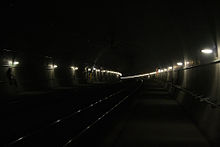A list of tunnels in Germany longer than 10 metres.
Contents
- Baden-Württemberg
- Road tunnels
- Railway tunnels
- Bavaria
- Road tunnels 2
- Railway tunnels 2
- Underground railway systems
- Berlin
- Road tunnels 3
- Railway tunnels 3
- Underground railway systems 2
- Hamburg
- Road tunnels 4
- Railway tunnels 4
- Underground railway systems 3
- Hesse
- Road tunnels 5
- Railway tunnels 5
- Underground railway systems 4
- Ship tunnels
- Mecklenburg-Vorpommern
- Road tunnels 6
- Lower Saxony
- Road tunnels 7
- Railway tunnels 6
- North Rhine-Westphalia
- Road tunnels 8
- Railway tunnels 7
- Rhineland-Palatinate
- Road tunnels 9
- Railway tunnels 8
- Saarland
- Road tunnels 10
- Railway tunnels 9
- Saxony
- Road tunnels 11
- Railway tunnels 10
- Schleswig-Holstein
- Road tunnels 12
- Thuringia
- Road tunnels 13
- External links




